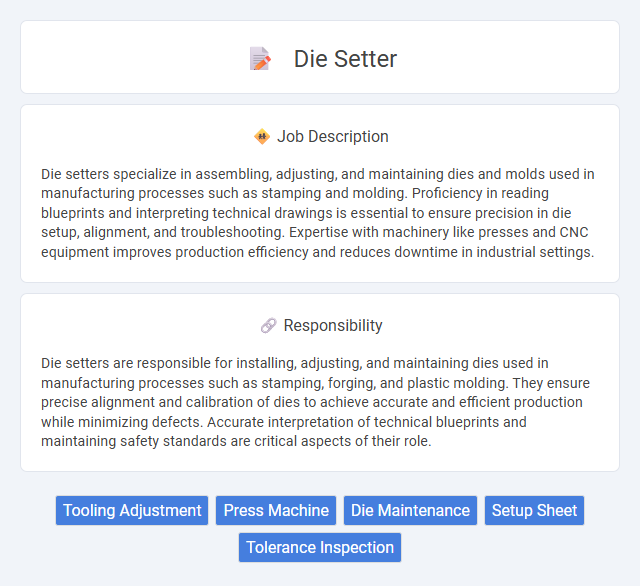
Die setters specialize in assembling, adjusting, and maintaining dies and molds used in manufacturing processes such as stamping and molding. Proficiency in reading blueprints and interpreting technical drawings is essential to ensure precision in die setup, alignment, and troubleshooting. Expertise with machinery like presses and CNC equipment improves production efficiency and reduces downtime in industrial settings.
Individuals with strong attention to detail and good hand-eye coordination are likely suitable for a die setter job, as it requires precise machine setup and adjustments. People who handle stress well and demonstrate patience may have a higher probability of success, given the repetitive and meticulous nature of the work. Those with poor manual dexterity or difficulty concentrating might struggle to meet the job's demands effectively.
Qualification
A die setter must possess technical skills in reading blueprints, interpreting engineering drawings, and understanding precise measurements for mold and die assembly. Proficiency in operating CNC machines, manual and hydraulic presses, and knowledge of material properties are essential for accurate adjustments and maintenance. Strong problem-solving abilities and experience in mechanical systems ensure efficient alignment and quality control throughout the die setting process.
Responsibility
Die setters are responsible for installing, adjusting, and maintaining dies used in manufacturing processes such as stamping, forging, and plastic molding. They ensure precise alignment and calibration of dies to achieve accurate and efficient production while minimizing defects. Accurate interpretation of technical blueprints and maintaining safety standards are critical aspects of their role.
Benefit
Working as a die setter likely offers competitive wages and opportunities for skill development in precision machining. Employees probably experience job stability due to the specialized nature of the role within manufacturing industries. Access to advanced equipment and hands-on technical training could further enhance career advancement prospects.
Challenge
Die setter jobs likely present challenges related to precision and technical expertise, as these roles require accurate setup and adjustment of dies for manufacturing processes. The probability of encountering difficulties increases with complex machinery and tight tolerances, demanding strong problem-solving skills and attention to detail. Adapting to evolving production technologies may also pose ongoing challenges for die setters in maintaining efficiency and quality.
Career Advancement
Die setters contribute to precision manufacturing by assembling and maintaining tooling dies used in metal stamping and molding processes. Mastery of technical skills in CNC programming and mechanical troubleshooting enhances opportunities for promotion to roles such as tool and die maker or manufacturing supervisor. Continuous skill development and certifications in advanced die design techniques can accelerate career advancement within the industrial production sector.
Key Terms
Tooling Adjustment
Die setter jobs focus primarily on precise tooling adjustments to ensure accurate alignment and optimal function of dies during manufacturing processes. Expertise in measuring equipment calibration, die setup, and fine-tuning tooling components contributes significantly to minimizing production errors and enhancing product quality. Proficiency in interpreting technical blueprints and maintaining tooling equipment is crucial for achieving efficient and consistent die performance.
Press Machine
A die setter operates and maintains press machines essential for shaping metal components in manufacturing. Precision in aligning dies and adjusting press settings directly impacts product quality and production efficiency. Knowledge of hydraulic and mechanical press systems is crucial for ensuring safe and accurate die installation and operation.
Die Maintenance
Die setters specialize in precise installation, alignment, and maintenance of dies used in manufacturing processes such as stamping and forging. Regular die maintenance ensures optimal performance by cleaning, inspecting for wear, performing repairs, and preventing tool damage, thereby extending die life and reducing downtime. Expertise in troubleshooting issues like tool breakage or misalignment is essential to maintain production quality and efficiency.
Setup Sheet
A die setter relies heavily on the setup sheet to ensure precise machine configurations and tooling alignment. This sheet contains critical parameters such as die dimensions, clearance settings, and press tonnage, which guide accurate die installation and reduce setup time. Proper interpretation and execution of the setup sheet directly impact production efficiency and part quality in progressive stamping operations.
Tolerance Inspection
Die setters perform precision tolerance inspections to ensure molds and dies meet exact specifications, using micrometers, calipers, and coordinate measuring machines (CMM). They analyze dimensional accuracy and surface integrity to prevent defects in manufacturing processes. Mastery of geometric dimensioning and tolerancing (GD&T) standards is essential for maintaining quality control and operational efficiency.
 kuljobs.com
kuljobs.com